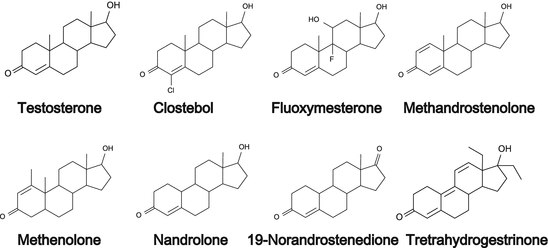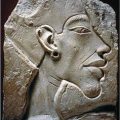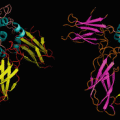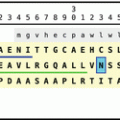and Winfried G. Rossmanith2
(1)
Lenzkirch, Germany
(2)
Ettlingen, Germany
15.1 Anabolic Steroids
15.2 β2-Agonists
15.3 Peptide Hormones
15.3.1 Gonadotropins
15.3.2 Corticotropin
15.4 Beta Blockers
15.5 Erythropoietin
The (ab)use of analeptics in daily life, above all as performance-enhancing drugs in endurance sports, has been made possible by new insights into endocrine regulation of basic metabolic circuits. National and international antidoping rules and regulations list the following compound classes as forbidden: analeptics, anesthetics, anabolics, diuretics, peptide hormones, beta blockers, and substances masking forbidden compounds.
Anabolic agents are almost exclusively preparations containing testosterone or its chemically synthesized derivatives. There are also agonists of noradrenaline/ adrenaline (β2-agonists), pituitary peptide hormones as well as their hypothalamic releasing hormones—among those already discussed are adrenocorticotropic hormone (ACTH ), choriogonadotropin (CG ), growth hormone (GH ), insulin , and luteinizing hormone (LH )—and aromatase inhibitors. Antagonists of noradrenaline/adrenaline, so-called beta blockers, are also listed as forbidden drugs. Also to be mentioned is erythropoietin , the drug of the last decade in endurance sports.
15.1 Anabolic Steroids
Synthetic testosterone analogs are considered as anabolic steroids (Fig. 15.1). By addition of a chlorine (clostebol) or the introduction of an additional unsaturated bond (methenolone or methandrostenolone) or a new methyl group at position 17 (methandrostenolone) or position 1 (methenolone), substances are generated whose actions as a sex hormone are reduced compared with the action of testosterone but whose metabolic activity is enhanced. These anabolic drugs stimulate muscle formation and reduce fat deposits.


Fig. 15.1
Anabolic steroids derived from testosterone. By addition of a chlorine or fluorine (clostebol, fluoxymesterone), by the introduction of an additional unsaturated bond (methenolone and methandrostenolone), by removal of the C-19 methyl group (nandrolone and 19-norandrostenedione), or by addition of an additional methyl group at position 1 (methenolone) or position 17 (fluoxymesterone and methandrostenolone), testosterone is changed in a way that aromatization to estradiol is completely blocked (see Fig. 6.19). Subsequently, enhanced muscle formation by long-living testosterone or its derivatives occurs (see Fig. 6.10 for the enumeration)
Tetrahydrogestrinone is a functional, but not a structural testosterone analog, and has a C-18 rather than a C-19 backbone, lacking the methyl group which is removed by aromatase (see Fig. 6.19) as in nandrolone or 19-norandrostenedione (Fig. 15.1). It was developed as a doping agent and never has never been used for medical treatment. The drug was found only after a syringe was anonymously handed to a US laboratory working for the US Anti-Doping Agency (Knight 2003).
Stay updated, free articles. Join our Telegram channel

Full access? Get Clinical Tree






